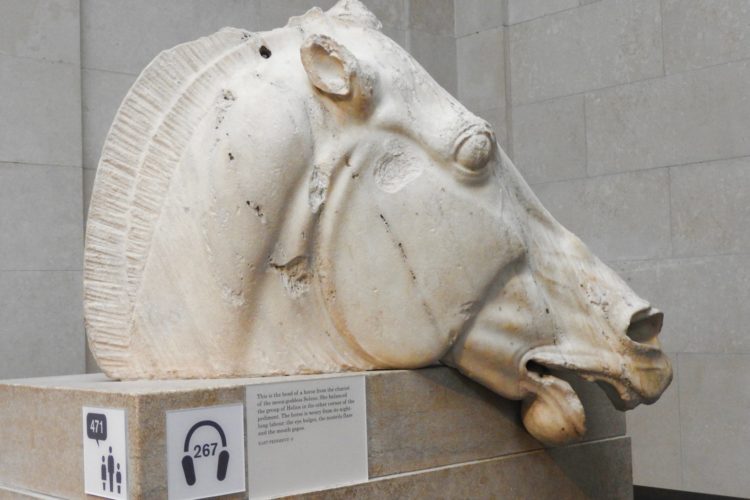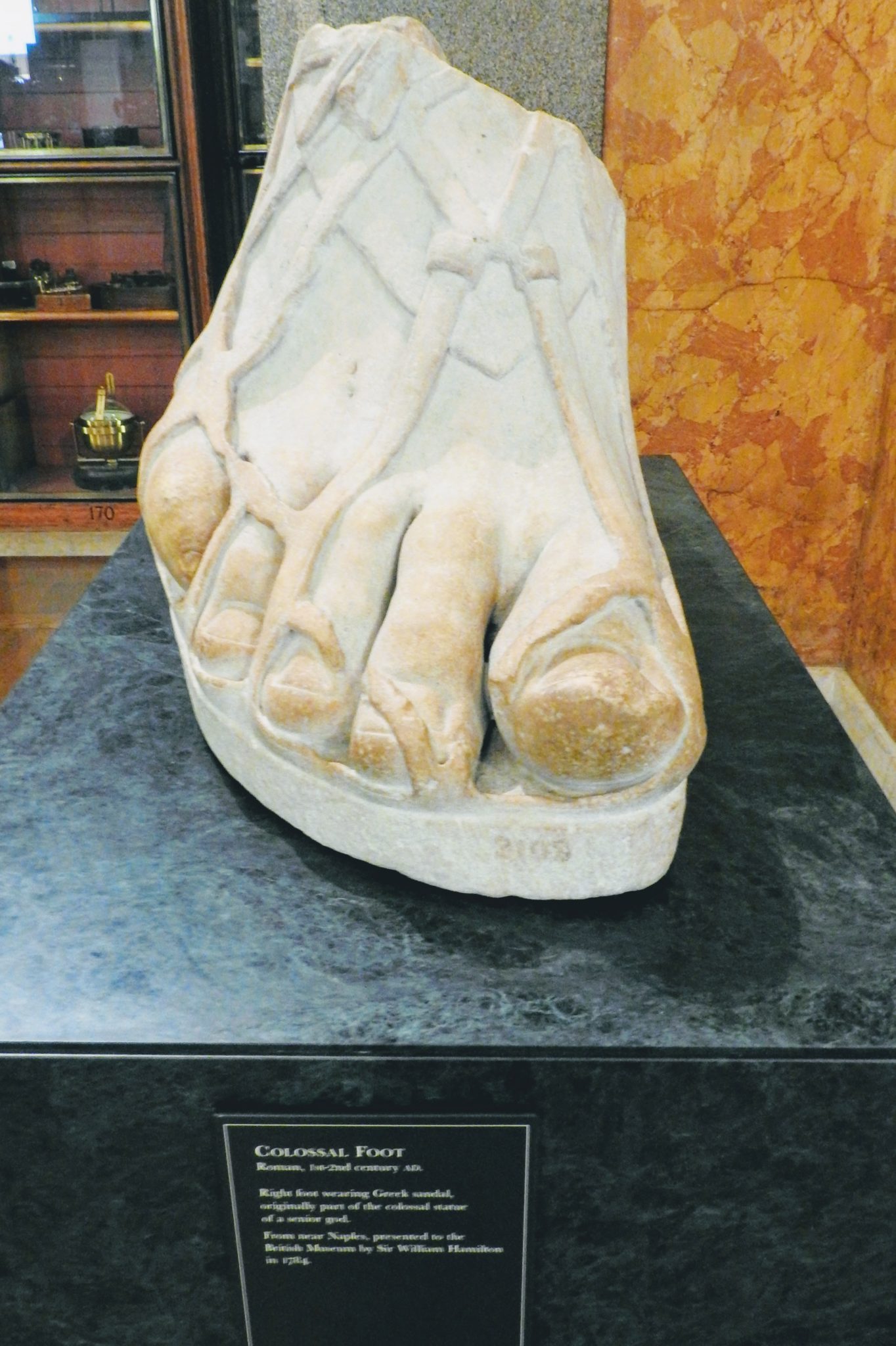
Wacky, Whimsical, Wonderful Wednesday, British Edition!
Hello everybody, and welcome to Wacky, Whimsical, Wonderful Wednesday, British edition. Grab a cup of tea (forgive me, a cuppa) and a pack of your favorite chocolate biscuits (it’s Wednesday, you deserve it), and together we’ll properly chase away the midweek blues.
Wacky
This marble sculpture fragment is labeled simply “Colossal Foot” and that pretty well sums it up. Affixed to a granite pedestal in the King’s Library at the British Museum, and standing about waist-high, it is impossible to overlook. It dates to the second century C.E., and, according to the affixed sign, belonged to a statue of a “senior god.” Which is good to know, because there really isn’t space in that room for any bigger feet. This one is pretty overpowering as it is.
There is something very vivid and earthy about this fragment, and I think it’s the jagged break at the top which conveys that (well, that and the sheer size of the thing). It doesn’t quite fit the tone of the Library, which is otherwise full of classically-inspired sculpture and dignified busts of various eighteenth century luminaries–all carefully lined up against sober glass-covered cabinets. I don’t remember if the Foot (its size seems to demand a capital “F”) is the only sculpture fragment in the room that actually dates to the classical period, but it is certainly the most memorable.
The foot (excuse me, Foot) has been in the British Museum’s collection since the 1780s. It was a gift from Sir William Hamilton, an enthusiastic antiquarian and amateur archaeologist who amassed a huge collection of artifacts while serving as British ambassador to the Kingdom of Naples. If you’re a fan of old movies, you might remember Hamilton as the wronged husband in Vivien Leigh and Laurence Olivier’s That Hamilton Woman.
[Let’s pause here and take a minute to reflect on the fact that it was once perfectly acceptable for ambassadors to essentially loot the countries in which they were posted. I’m pretty sure there are laws about that now.]
Even if enormous and dramatic Foot is out of place in the King’s Library, I’m glad it’s there. It’s a nice reminder to visitors that the eighteenth century worthies whose excavations, collections, and examinations are celebrated in this room weren’t working on a blank canvas. They were engaging with–and usually disrupting–remnants of a very real past which had meaning for the people and cultures around it. That’s something worth bearing in mind if, like me, you’re a museum geek.
Whimsical

Okay, what is with this trend toward strewing historic sites with fake animals? I’ve already written about my reaction to the decidedly unnerving eagles on display at Mont-Saint-Michel, and I found these sculptures at the Tower of London no less creepy.
In 2010, Historic Royal Palaces, the organization responsible for the accurate historical curation of Britain’s royal buildings, commissioned an artist named Kendra Haste to make thirteen animal sculptures for the Tower grounds. The sculptures, all made from chicken wire, will be on display through 2021–so there is plenty of time for you to be creeped out by them too!
The whole installation is meant to evoke the Tower’s past as the home the Royal Menagerie, the name given to the royal collection of exotic animals. For six centuries, the menagerie hosted all kinds of distinctly non-British wildlife, from polar bears to African elephants. These fellas here are known as the “three lions,” but if you’re thinking that two of them don’t look particularly lion-like, you are right.
In 1235, the Holy Roman Emperor gave King Henry III a gift of “three leopards,” because that is what kings did in those days to impress each other. However, there’s some confusion about what kind of animals they actually were. Most historians now think that they were lions (which makes sense, given the three lions on Henry’s sigil), but excavations at the Tower have turned up the skull of an actual leopard, so who knows. Perhaps the Holy Roman Emperor thought “leopard” just sounded cooler. Or perhaps he could see into the future and knew that Henry’s heir, Edward I, would one day be known as the “leopard prince.”
As for the ambiguous leopard-ish lions in Haste’s design, perhaps she got as frustrated as I did trying to track down the history of the Tower’s leopard-lions and decided to just split the difference. Whatever her intent, I’d say she succeeded in conjuring up the Tower’s old menagerie. Somehow, these sculptures manage to appear life-like and spectral at the same time, evoking the Tower’s many, many ghosts–both animal and human. I suggest that those of us with overactive imaginations avoid the Tower after dark…
Wonderful

Ah, a nice, calm, unthreatening scenic view! No colossal feet, no creepy wire animals, just a mid-July sunset over the River Ouse in York.
I tend to prefer sunsets to sunrises (good thing too, since I am not a morning person), but I find summer sunsets especially magical. Maybe it’s because the sun goes down so much later in summer (this photo was taken a little past 9 pm). In most places the evening rush is over and unless you are in a very big city, it is not too difficult to find a peaceful place to watch the sun disappear over the horizon. As an added bonus, it’s a golden time for picture-taking. The changing light means a new view every other minute and there are fewer (or no) people around to get in the way!
So, what do you think? Do sunsets beat sunrises? Am I the only person who thinks the “Foot” has stubbed its big toe? And what about those wire animals? Am I overreacting, or do you find them creepy too? Let me know in the comments section!
P.S. The featured photograph at the top of the post is of a fragment of a sculpture of the moon goddess’ horse. It was originally part of the decoration at the Parthenon but is now in the British Museum. Because two marble body part fragments are always better than one!





This Post Has 0 Comments